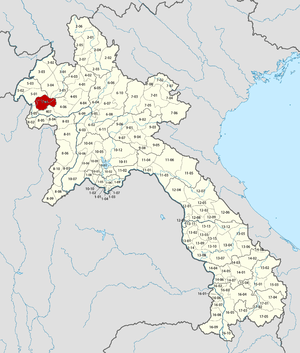Pha Oudom District
Pha Oudom District is a district (muang) of Bokeo Province in northwestern Laos.[1] The district, along with Pak Tha District, was part of Oudomxay Province until 1992.
Pha Oudom District ເມືອງຜາອຸດົມ | |
|---|---|
 Location in Laos | |
| Country | Laos |
| Province | Bokeo Province |
| Area | |
| • Total | 610 sq mi (1,579 km2) |
| Population | |
| • Total | 36,400 |
| • Density | 60/sq mi (23/km2) |
| Time zone | UTC+7 (ICT) |
Geography
The district is about 50 kilometres southeast of the town of Houayxay and covers an area of 1,579 square kilometres.[2] The district is bordered by Houayxay District to the northwest; Na Le District and Viengphoukha District of Luang Namtha Province to the northeast; Houne District of Oudomxay Province to the east; Pakbeng District to the south; and Pak Tha District of Bokeo to the west.[2] It has a population of about 36,400 people.[2] The district is remote and mountainous can be divided into two regions: highlands at 800 metres above sea level which comprises about 65% of the land area and lowlands at 400 metres elevation.[3] The Nam Tha River is the chief watercourse in the district.
Settlements
Pha Oudom contains 94 villages, 54 of them are among the poorest communities in Laos.[2] The inhabitants mainly consist of Khmu peoples who constitute about 80 percent of the district population, followed by 12 percent lowlander, and eight percent Hmong.[2] The oldest village in the district is Namkha, established in 1906.[2]
Economy
The economy is based on rice farming and animal husbandry including buffalo.[3] The people are also experienced in handicrafts and collecting non-timber forest products and paper mulberry is also one of the main income generating activities.[2] There are also numerous teak and rubber plantations in the district. Since irrigation for paddy rice cultivation was introduced in 2006 many people have turned to cultivating rice.[2]
Many of the villages have no electricity, no road access and no running water, and often no sanitation. Australian activists working for Plan have noted that because the district is so remote it is one of the poorest in Laos. Plan are working to improve sanitation, hygiene and water supply in the region.[4]
The provincial government has aimed to encourage more villagers in the isolated mountainous regions to move into the lowland to get better access to civil amenities such as roads, markets, schools, and healthcare centers.[2] Land use planning and land allocation policies by the government aim to reduce deforestation which is a problem in Pha Oudom District and to promote sustainable land use.[2]
References
- Maplandia world gazetteer
- Thongphanh, Daovorn. "Impacts of Land and Forestland Allocation Policy on Livelihood in the Lao PDR: A case study of Pha-oudom District, Bokeo Province" (PDF). RECOFTC. Retrieved 4 November 2009.
- "Physical environment and farming in Pha Oudom district, Bokeo province, northern Laos". Institute of Tropical Agriculture, Kyushu University. 2008. Retrieved November 4, 2009.
- "Mobilising Communities to Improve Sanitation, Hygiene and Water in Laos". Plan. Archived from the original on October 24, 2012. Retrieved November 4, 2009.